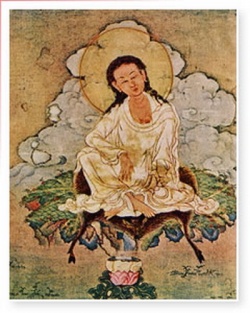Prakṛti
Prakrti or Prakriti or Prakruti (from Sanskrit language प्रकृति, prakṛti) means "nature". It is, according to Hinduism, the basic nature of intelligence by which the Universe exists and functions It is described in Bhagavad Gita as the "primal motive force".
It is the essential constituent of the universe and is at the basis of all the activity of the creation. The one god mentioned in the Vedas has two main parts, Prakrti and Purush, and all gods which Hindus worship are just an instance of the Purush while
goddesses are instances of Prakrti (sometimes called Adi-Shakti). According to Samkhya and Bhagavad Gita Prakrti or Nature is composed of the three gunas which are tendencies or modes of operation, known as sattva (creation), rajas (preservation), and tamas, (destruction) Sattva encompasses qualities of goodness, light, and harmony.
According to the Yoga Vasistha, people who are of a sattvic nature and whose activities are mainly based on sattva, will tend to seek answers regarding the origin and truth of material life. With proper support they are likely to reach liberation. Rajas is associated
with concepts of energy, activity, ambition, and passion; so that, depending on how it is used, it can either have a supportive or hindering effect on the evolution of the soul. Tamas is commonly associated with inertia, darkness, insensitivity.
Souls who are more tamasic are considered imbued in darkness and take the longest to reach liberation. Prakriti is closely associated with the concept of Maya within Vedic scripture.
Mulaprakruti can be translated as "the root of nature" or "root of Prakruti"; it is a closer definition of 'fundamental matter'; and is often defined as the essence of matter, that aspect of the Absolute which underlines all the objective aspects of
Nature. While plain Prakruti encompasses classical earth element, i.e. solid matter, Mulaprakruti includes any and all classical elements, including any considered not discovered yet (some tattvas.)
Devi prakruti shakti in the context of shaktis as forces unifies kundalini, kriya, itcha, para, jnana and mantrika shaktis. Each is in a chakra.
Prakruti also means nature. Nature can be described as environment. It can also be used to denote the 'feminine' in sense of the 'male' being the purusha. Prakriti also means health in Marathi.
According to the ancient vedic science of Ayurveda, the three gunas (sattva, rajas and tamas) as they pertain to the human physiology are called doshas: kapha, pitta, vata. The balance or imbalance of these doshas defines the prakriti or nature of one's body.

